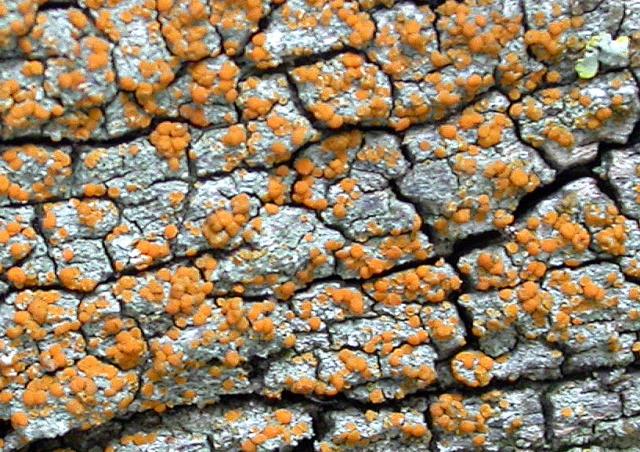A crustose lichen that forms deep orange patches on the trunks of mature trees, particularly old elms and sycamores.
Immediately obvious as deep orange patches on bark or lignum, the thin grey-white thallus is inconspicuous and is dominated by the numerous, crowded, deep orange apothecia (generally 0.3 - 0.5 mm diameter). These are concave at first but become convex when mature.
May be confused with Caloplaca ulcerosa, which has similar apothecia but has pustular grey soralia, and with C. phlogina (of the C. citrina aggregate) whose pale yellow soralia are often inconspicuous in the field. Other corticolous species with a pale thallus and yellow-orange apothecia are C. cerinella, C. cerinelloides, and the normally saxicolouus C. holocarpa. None of these has the small ascospore size (8-12 x 3-6um) and narrow ascospore septum characteristic of C.luteoalba.
Saxicolous records are often errors for Caloplaca arenaria or C. lactea, both of which have larger ascospores (>12um).
It favours well-lit, dry, sunny trees with a basic bark, and may be found on the bark or on exposed lignum, usually towards the base of the trunk where the bark or wood is nutrient-enriched from sap exuding from wounds, or impregnated by dung-enriched dust. Before the advent of Dutch Elm disease, elm was its favoured host tree but more recently it has been found occasionally on sycamore, field maple and ash. More rarely it occurs on calcareous stone or mortar.
Caloplaca luteoalba is often found with Bacidia incompta, forming a distinctive, species-poor community that belongs to the Xanthorion parietinae.
No lichenicolous fungi have been reported.

Native and formerly widespread, it is now occasional in lowland Britain, mostly in eastern England and Scotland, and rare in high rainfall areas except near the coast. The distribution map is misleading as many of the post-1960 records are of populations that are now lost.
Worldwide it occurs from north-central Europe to Iran, also in North America.
Populations declined rapidly after the outbreak of dutch elm disease in the 1970s, as many of the host trees were lost. It is also threatened by the loss of wayside trees, and by intensive agriculture leading to excessive nutrient enrichment.
Coppins, A.M. & Coppins, B.J. (1998) Species dossier: Caloplaca luteoalba. Scottish Natural Heritage.
Coppins, A.M. & Coppins, B.J. (2001) Caloplaca luteoalba. Species account 0266 in the Lichen Atlas of the British Isles. British Lichen Society, London.

